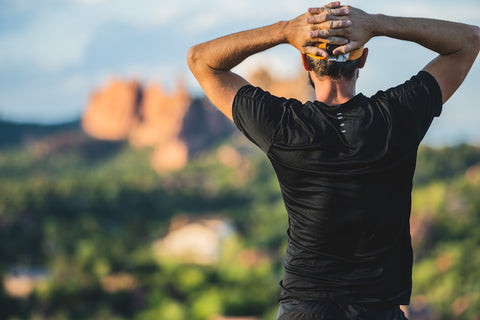Why is moisture wicking baselayers crucial when you go hiking or trekking?
COTTON KILLS. This is a phrase that you will hear over and over again and seems to be a hiking & trekking 101 when choosing what clothing you take on your trip. The reason behind this saying is that cotton absorbs and holds onto a lot of moisture (up to 27 times its own weight!) which can be dangerous under cold weather conditions. When your clothing is wet, moisture evaporates and takes away body heat, and in cold weather conditions, because it takes cotton a long time to dry, wet cotton fabric loses its insulating performance and can quickly lead to hypothermia (excess body heat loss).

Shopping for outdoor clothing in the modern days, you would unavoidably come across baselayers and T-shirts that are marketed as moisture wicking and quick dry. Quick dry as its name suggests, is relatively easy to understand, which means the fabric used for the garment dries quickly, but what does “moisture wicking” mean?
Wicking is the result of a physical phenomenon called capillary action which draws liquid and transport it along a medium. Ever wonder how candles keep burning? This is exactly how it works and where the wicking name came from! When you light your candle, the heat melts the wax and it's pulled up the wick by the capillary action, which keeps the supply of the fuel to sustain the burning.

The reason moisture wicking is essential for hiking and trekking baselayers is because it helps to move moisture away and distribute it evenly along the fabric surface when you sweat and increases the rate of drying. When you are active, your body temperature goes up and your body naturally sweat to cool itself. The moisture wicking performance allows sweat to evaporate efficiently and hence cool your body, and by not holding up excess amount of moisture, you stay insulated and prevent excess heat loss. You can learn how Koup's materials are designed to excel on this.
Materials good for moisture wicking:
Polyester/ Nylon: These are popular synthetic options. Polyester itself is hydrophobic which means it does not absorb water, making it ideal as a natural moisture wicking and quick dry material. Nylon, although does absorb a little bit of water so it dries a little slower than polyester, is moisture wicking and usually softer than polyester. Modern technology can further improve moisture wicking performance by using performance enhancing finishes but will eventually wash off and is harmful to the environment. Other downsides of polyester and nylon is that both materials are derived from petroleum and tend to be seen as less friendly to the environment and they are also prone to odor build-up. At Koup, we engineer our yarns with a special shape, so we boost the moisture wicking performance of our clothing without the use of short-lasting harmful chemicals. We also use recycled bottle as our source for polyester, so we do not use new petroleum sources, and the patented cinnamon technology eliminate the problem of odor from standard polyester. Find out more on why Koup is different
Merino wool: Merino wool has become a widely popular choice for the outdoor community because of its performances and is a natural and biodegradable material when not mixed with other synthetic fibres. It comes from a special breed of sheep called Merino which originates from Spain but more famously found in Australia & New Zealand nowadays (and also other South American countries). Merino wool is finer than normal wool which makes it more comfortable to wear and its porous structure makes it moisture wicking and absorbs odor. Merino is also breathable and retains heat when wet, making it a good thermal regulating layer. The only down side is that it does dry slower compared to synthetics and are less durable than synthetics because the fibres are weaker. There are also concerns about mulesing and other animal welfare issues, so it's a no go if you are a vegan or concerned about animal welfare.

Rayon/ Modal/ Lyocell (Tencel): These are plant based fibres (made from wood) but are man-made because they are processed into pulps and then spun into fibres, unlike cotton where it's used in its natural form. Rayon is soft, breathable, cooling and also dries and wicks moisture quickly compared to cotton, but again, not as well as synthetics because it still absorbs water. One big issue with traditional rayon is that the chemical solvents that are used to process wood into wood pulp are highly toxic and the source of wood is not regulated which has environmental concerns such as deforestation and also illegal discharge of toxic chemicals. Lyocells is a modern version of rayon (such as Tencel & other trademarks) has addressed this concern to replace toxic chemicals with more eco-friendly alternatives and also making the process close-loop, meaning the chemical used is recycled and stay in the system. The source of the wood used for the material is also strictly monitored to comply with the Forest Stewardship Council standard (FSC) to ensure the sources are as sustainable as possible.
Hemp/ Linen : Hemp and linen have existed for centuries as textile fibres and are making a comeback. They are natural, durable, breathable and moisture wicking. They are getting more attention because of their low impact on the environment during cultivation since no pesticides and irrigation is needed. However, the downside is that they are not as easy to maintain and not as soft on the skin compared to other alternatives so are mainly used as blends with cotton and other fibres.
Shop Koup's moisture wicking collection
Photo credits:
Photo by Manoj Bisht from Pexels
Photo by Felix Mittermeier from Pexels

Leave a comment
Please note, comments must be approved before they are published